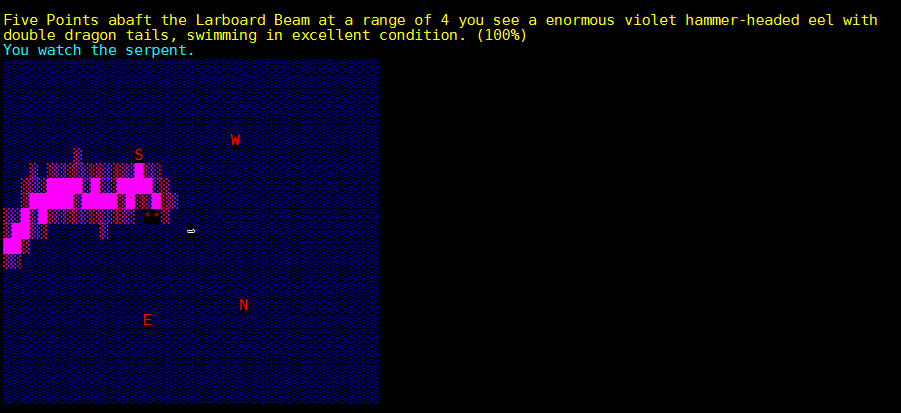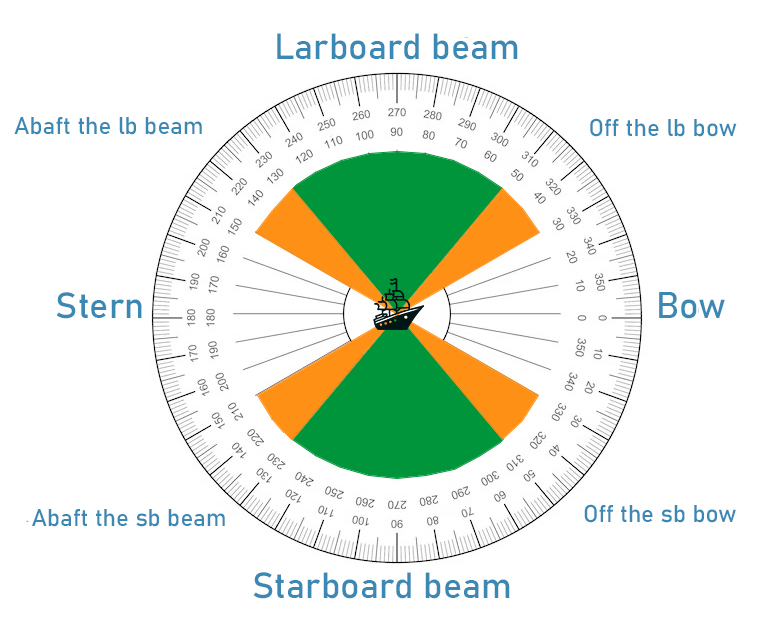 |
 |
 |
 |
| Step by step guide on how to kill a serpent |
|
Chum
The first thing you need is chum to attract a serpent. If you have no serpent meat available from a friendly clan member, you can use fish. You can fish off the side of your ship with a fishing net. Once you have a decent amount of fish, you can start trying to chum up a serpent. Fish will only attract small serpents. To chum head to the edge of the ship, as a captain, a recommended spot is 2 west of the helm. With the meat or fish in your inventory type, Ship chum, you will see "You begin tossing morsels of food over the fantail". If you run out of chum will you be prompted with "Having run out of chum, you stop casting it over the stern." If successful, you will see a message similar to: A freshly chummed serpent will swim alongside you for a while, allowing you to decide if you want to take it on or not. If not, simply ignore it, and it will eventually go away.
This screenshot shows a freshly chummed serpent swimming alongside the ship long enough to get a report of what we have chummed. Firing on a serpentThe first rule of shooting on a ship is to never fire while turning. If you are turning you will miss! SHIP CO 0 before every volley It is always preferable to fire on a serpent in a volley. The volley increases your chances of hitting. In our example above, we would shout fire lb The trick now is to keep the serpent at an angle relative to your ship where your shots will hit. If the gun has no bearing on the serpent, the deckhand will not fire. If the deckhand does not fire you will get rammed! In some cases this can be covered by your stern guns but should not be relied on if avoidable. Your LB and SB guns will have guaranteed bearing on the serpent from about -40 to +40 from the beam. From -40/+40 to around -60/+60 your deckhands will have a higher chance of missing. From -70/+70 you will only be able to fire with stern guns.
To guarantee that you hit the serpent, it is recommended to try and keep the serpent's head when attacking within the green. In the orange, the chances of missing are increased. Once you have fired on the serpent that you chummed it is now aggro towards you, and it will begin to charge. The first thing it does after you initiate the attack is dive. It will then circle your ship for a while. Before the serpent surfaces and starts its attack, you will have a warning of what the serpent is planning. You will see a message similar to "below the surface 3 points off the starboard beam you see a flicker of ruby below the surface". What this shows us is, the serpent will probably surface on starboard more or less 30 degrees behind the starboard beam. You can begin to turn and line up your shot already before it surfaces. Only once surfaced will you know for sure what bearing the serpent is ramming from. Head shotYour goal now is to prevent the serpent from hitting your ship. To do this, we must hit a head shot which will turn the serpent away. Ideally, you will fire your main guns in a large volley. In an emergency, you can use your stern or bow. Firing rangeIt will be up to you to learn at exactly what range to instruct your deckhands to fire. The level of the deckhands will play a major role in figuring out when to shout. More experienced master deckhands will respond faster than green journeymen. Baby serpents are in range of a head shot from range 1-10 Larger serpents will need to be closer at around a range of 1-7. The guarantee of a head shot for larger serpents is the range of 5 or less. A serpent can be fired upon up to a range of 15. This tactic is best used when the serpent is heading away from you. Once you have determined their speed and behaviour you can start firing as it swims away. Keep a watchful eye in the serpent's range. Once it turns and starts reducing distance, you may want to stop firing until it's in range of a head shot again. Firing split decksFiring your top and bottom decks separately is a good tactic to guarantee that head shot. You can fire the top deck at range 7 and the lower a few seconds later, and you will more than likely never miss provided your guns are facing the serpent. Experiment with split deck firing to find how it can be best worked into your strategy. Diving serpentsOften, after you hit a serpent, it will dive and will no longer turn to attack. Instead, it will circle your ship waiting for an opportunity to attack again. Often it will pop up and swim alongside your ship. Firing when this happens gives you a damage bonus, BUT be careful that the serpent that popped up might not be the one you were fighting, and now you have two serpents to deal with! Splitting serpentsSerpents sized enormous and larger with multiple heads will more than likely split. The number of babies depends on the size of the serpent, with an epic often spawning 30 or more. When a serpent splits, you will be unable to ship quit for 10 minutes. In most cases, you should have no problem dealing with baby serpents. Remember the range to get a head shot is higher for baby serpents. It is also recommended to fire volleys by deck so that you are not caught with your proverbial pants down and no guns loaded. Dartfilingers will deal more damage to baby serpents, so if you have these on the stern, try to use them to your advantage. The only serpent which may cause you real trouble when it splits is an epic. The number of babies can be overwhelming even for the most seasoned ship captain. As epics have a massive amount of hp you will often be able to sail close to the docks where you can now use safe waters to help you deal with chaos. By weaving in and out of safe water, you can give your senses a break and have your deckhands repair before heading back into hazardous water. Another more frowned-upon approach is to head to the docks and leave your serpent spawn to terrorize the high seas. Ship quit is also an option if you can survive the 10-minute lock out when a serpent splits as well as the 5-minute timer if actively under attack by serpents. This method is very risky. Copyright © 1992- Medievia.com, Inc.All Rights Reserved. For more information contact: Webmistress: Soleil |

